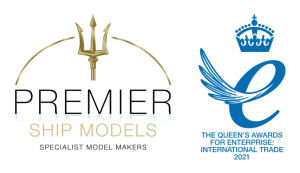3D Rendering
Using a combination of blueprints, photos and research we are able to create a set of renders for a ship. These renders are sent to our clients to review and provide feedback before we start building the model. The process of 3D rendering allows the client to provide critical feedback before any production starts, saving time and money.
Renders are predominantly produced in two different formats; 1) photorealistic renders and 2) colour coded renders. The photorealistic renders give the client a realistic interpretation of what the finished model will look like including colour schemes and wood tones. The colour coded renders explain from what source we obtained the information to produce the renders.
1) Blue is taken from photos of the ship
2) Red is taken from the blueprints of the ship
3) Green are details added from looking at pictures of similar ships (either sister ships or ships of the same type from the same era
4) Yellow are details added on the basis that these features would be needed in order for the ship to function correctly (i.e from research and knowledge)
If the client wanted to use the renders for more than just review purposes we can provide stylised renders [essentially filters on the original model] so the client may wish to use them for wall mounted pictures
Finally we can also use the 3D renders to create a Virtual Reality that the client can use to explore the 3D model either through their computer or a VR headset. Using the arrow keys on the computer and the mouse to look around, an example of this is seen in the video on the right. This experience is for the client to keep, allowing them to enjoy their model either through the static display of a physical model or through VR
VR Walkthroughs
We strongly believe that immersive Virtual Tours will quickly become the industry standard for most hospitality sectors. As a technology it is already becoming widespread in the real estate, architectural and entertainment sectors with companies such as Purple Bricks and Zoopla for example, offering Virtual Tours as standard for all new listings. In the hospitality industry many of the larger hotel chains are adopting this including Hilton, Mercure, Doyle Collection and Ramada. It is also beginning to appear in other areas such as wedding locations, boat makers and cruise companies, activity centres such as climbing and bouldering sites and many more. Where there is an activity or feature that a company would like to showcase, Virtual Tours give the customers a real world sneak preview before coming to experience it for themselves.
As well as a excellent marketing tool, Virtual Tours have many other more practical uses, here are just a few of them:
- Showcase the quality of your spaces with more than just static images.
- ‘Tag’ key features within spaces to enrich a customers experience and help answer their common questions.
- Each scan can output 4K Quality Static Photos for use by your marketing team.
- Each scan is also a full architectural survey of each space, correct to 1% accuracy. These are commonly used by FM [Facility Management] departments for ‘point in time’ photo surveys of projects so progress or wear and tear can be monitored during a projects lifespan. These are especially important for insurance purposes.
- Each scan can also be interrogated with measuring tools [by the creator, not your customers] so you are always up to speed on spatial concerns without having to physically hand measure each time you need to check a dimension.


